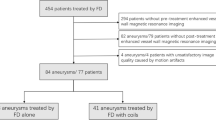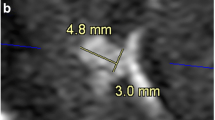Abstract
Purpose
While follow-up assessment of clipped aneurysms (CAs) using magnetic resonance angiography (MRA) can be challenging due to susceptibility artifacts, a novel MRA sequence pointwise encoding time reduction with radial acquisition (PETRA) subtraction-based MRA, has been developed to reduce these artifacts. The aim of the study was to validate the diagnostic performance of PETRA-MRA by comparing it with digital subtraction angiography (DSA) as a reference for follow-up of CAs using a 3T MR scanner.
Methods
Patients with clipping who underwent both PETRA-MRA and DSA between September 2019 and December 2021 were retrospectively included. Two neuroradiologists independently reviewed with the reconstructed images of PETRA-MRA to assess the visibility of the arteries around the clips and aneurysm recurrence or remnants of CA using a 3-point scale. The diagnostic accuracy of PETRA-MRA was evaluated in comparison to DSA.
Results
The study included 34 patients (28 females, mean age 59 ± 9.6 years) with 48 CAs. The PETRA-MRA allowed visualization of the parent vessels around the clips in 98% of cases, compared to 39% with time-of-flight (TOF) MRA (p < 0.0001). The DSA confirmed 14 (29.2%) residual or recurrent aneurysms. The PETRA-MRA demonstrated a high accuracy, specificity, positive predictive value, and negative predictive value of 99.2%, 100%, 100%, and 97.8%, respectively, while the sensitivity was 66.7%.
Conclusion
This retrospective study demonstrates that PETRA-MRA provides excellent visibility of adjacent vessels near clips and has a high diagnostic accuracy in detecting aneurysm remnants or recurrences in CAs. Further prospective studies are warranted to establish its utility as a reliable alternative for follow-up after clipping.

Similar content being viewed by others
References
Lin T, Fox AJ, Drake CG. Regrowth of aneurysm sacs from residual neck following aneurysm clipping. J Neurosurg. 1989;70:556–60.
Tsutsumi K, Ueki K, Usui M, Kwak S, Kirino T. Risk of recurrent subarachnoid hemorrhage after complete obliteration of cerebral aneurysms. Stroke. 1998;29:2511–3.
David CA, Vishteh AG, Spetzler RF, Lemole M, Lawton MT, Partovi S. Late angiographic follow-up review of surgically treated aneurysms. J Neurosurg. 1999;91:396–401.
Juvela S. Risk of subarachnoid hemorrhage from a de novo aneurysm. Stroke. 2001;32:1933–4.
Tsutsumi K, Ueki K, Morita A, Usui M, Kirino T. Risk of aneurysm recurrence in patients with clipped cerebral aneurysms: results of long-term follow-up angiography. Stroke. 2001;32:1191–4.
van der Schaaf IC, Velthuis BK, Wermer MJ, Majoie C, Witkamp T, de Kort G, Freling NJ, Rinkel GJ, Group AS. New detected aneurysms on follow-up screening in patients with previously clipped intracranial aneurysms. comparison with DSA or CTA at the time of SAH. Stroke. 2005;36:1753–8.
Wermer MJ, van der Schaaf IC, Velthuis BK, Algra A, Buskens E, Rinkel GJ, Group AS. Follow-up screening after subarachnoid haemorrhage. frequency and determinants of new aneurysms and enlargement of existing aneurysms. Brain. 2005;128:2421–9.
Wallace RC, Karis JP, Partovi S, Fiorella D. Noninvasive imaging of treated cerebral aneurysms, Part II: CT angiographic follow-up of surgically clipped aneurysms. AJNR Am J Neuroradiol. 2007;28:1207–12.
Kaufmann TJ, Huston J 3rd, Mandrekar JN, Schleck CD, Thielen KR, Kallmes DF. Complications of diagnostic cerebral angiography: evaluation of 19,826 consecutive patients. Radiology. 2007;243:812–9.
Jager HR, Mansmann U, Hausmann O, Partzsch U, Moseley IF, Taylor WJ. MRA versus digital subtraction angiography in acute subarachnoid haemorrhage: a blinded multireader study of prospectively recruited patients. Neuroradiology. 2000;42:313–26.
Heo YJ, Jeong HW, Baek JW, Kim ST, Jeong YG, Lee JY, Jin SC. Pointwise Encoding Time Reduction with Radial Acquisition with Subtraction-Based MRA during the Follow-Up of Stent-Assisted Coil Embolization of Anterior Circulation Aneurysms. Ajnr Am J Neuroradiol. 2019;40:815–9.
You SH, Kim B, Yang KS, Kim BK, Ryu J. Ultrashort Echo Time Magnetic Resonance Angiography in Follow-up of Intracranial Aneurysms Treated With Endovascular Coiling: Comparison of Time-of-Flight, Pointwise Encoding Time Reduction With Radial Acquisition, and Contrast-Enhanced Magnetic Resonance Angiography. Neurosurgery. 2021;88:E179–e89.
Heo YJ, Jeong HW, Kim D, Baek JW, Han JY, Choo HJ, Kim ST, Jeong YG, Jin SC. Usefulness of pointwise encoding time reduction with radial acquisition sequence in subtraction-based magnetic resonance angiography for follow-up of the Neuroform Atlas stent-assisted coil embolization for cerebral aneurysms. Acta Radiol. 2021;62:1193–9.
Ebiko Y, Wakabayashi H, Okada T, Mizoue T, Wakabayashi S. Usefulness of PETRA-MRA for Postoperative Follow-Up of Stent-Assisted Coil Embolization of Cerebral Aneurysms. J Neuroendovasc Ther. 2023;17:188–95.
Sato K, Asano A, Kobayashi T, Aoki H, Jinguji S, Seto H, Demachi H, Hasegawa H, Fujii Y. Validity of PETRA-MRA for Stent-Assisted Coil Embolization of Intracranial Aneurysms. J Neuroendovasc Ther. 2021;15:352–9.
Kim JH, Ahn SJ, Park M, Kim YB, Joo B, Lee W, Suh SH. Follow-up imaging of clipped intracranial aneurysms with 3‑T MRI: comparison between 3D time-of-flight MR angiography and pointwise encoding time reduction with radial acquisition subtraction-based MR angiography. J Neurosurg. 2021; https://doi.org/10.3171/2021.7.JNS211197.1-6.
Nishikawa A, Kakizawa Y, Wada N, Yamamoto Y, Katsuki M, Uchiyama T. Usefulness of Pointwise Encoding Time Reduction with Radial Acquisition and Subtraction-Based Magnetic Resonance Angiography after Cerebral Aneurysm Clipping. World Neurosurg. 2021;X(9):100096.
Sindou M, Acevedo JC, Turjman F. Aneurysmal remnants after microsurgical clipping: classification and results from a prospective angiographic study (in a consecutive series of 305 operated intracranial aneurysms). Acta Neurochir (wien). 1998;140:1153–9.
Landis JR, Koch GG. The measurement of observer agreement for categorical data. Biometrics. 1977;33:159–74.
Kim JH, Lee KY, Ha SW, Suh SH. Prevalence of Unruptured Intracranial Aneurysms: A Single Center Experience Using 3T Brain MR Angiography. Neurointervention. 2021;16:117–21.
Gruwel MLH, Latta P, Wojna-Pelczar A, Wolfsberger S, Tomanek B. MR imaging of tissue near aneurysm clips using short- and zero time MR sequences. Measurement. 2018;130:398–403.
Holdsworth SJ, Macpherson SJ, Yeom KW, Wintermark M, Zaharchuk G. Clinical Evaluation of Silent T1-Weighted MRI and Silent MR Angiography of the Brain. AJR Am J Roentgenol. 2018;210:404–11.
Fu Q, Zhang XY, Deng XB, Liu DX. Clinical evaluation of subtracted pointwise encoding time reduction with radial acquisition-based magnetic resonance angiography compared to 3D time-of-flight magnetic resonance angiography for improved flow dephasing at 3 Tesla. Magn Reson Imaging. 2020;73:104–10.
Grodzki DM, Jakob PM, Heismann B. Ultrashort echo time imaging using pointwise encoding time reduction with radial acquisition (PETRA). Magn Reson Med. 2012;67:510–8.
Katsuki M, Narita N, Ishida N, Sugawara K, Watanabe O, Ozaki D, Sato Y, Kato Y, Jia W, Tominaga T. Usefulness of 3 Tesla Ultrashort Echo Time Magnetic Resonance Angiography (UTE-MRA, SILENT-MRA) for Evaluation of the Mother Vessel after Cerebral Aneurysm Clipping: Case Series of 19 Patients. Neurol Med Chir (tokyo). 2021;61:193–203.
van Loon JJ, Yousry TA, Fink U, Seelos KC, Reulen HJ, Steiger HJ. Postoperative spiral computed tomography and magnetic resonance angiography after aneurysm clipping with titanium clips. Neurosurgery. 1997;41:851–6. discussion 6–7.
Kim HJ, Yoon DY, Kim ES, Yun EJ, Jeon HJ, Lee JY, Cho BM. 256-row multislice CT angiography in the postoperative evaluation of cerebral aneurysms treated with titanium clips: using three-dimensional rotational angiography as the standard of reference. Eur Radiol. 2020;30:2152–60.
Sagara Y, Kiyosue H, Hori Y, Sainoo M, Nagatomi H, Mori H. Limitations of three-dimensional reconstructed computerized tomography angiography after clip placement for intracranial aneurysms. J Neurosurg. 2005;103:656–61.
Dehdashti AR, Binaghi S, Uske A, Regli L. Comparison of multislice computerized tomography angiography and digital subtraction angiography in the postoperative evaluation of patients with clipped aneurysms. J Neurosurg. 2006;104:395–403.
Xiang S, Fan F, Hu P, Yang K, Zhai X, Geng J, Ji Z, Lu J, Zhang H. The sensitivity and specificity of TOF-MRA compared with DSA in the follow-up of treated intracranial aneurysms. J Neurointerv Surg. 2021;13:1172–9.
Guermazi A, Miaux Y, Zaim S, Peterfy CG, White D, Genant HK. Metallic artefacts in MR imaging: effects of main field orientation and strength. Clin Radiol. 2003;58:322–8.
Li MH, Li YD, Tan HQ, Gu BX, Chen YC, Wang W, Chen SW, Hu DJ. Contrast-free MRA at 3.0 T for the detection of intracranial aneurysms. Neurology. 2011;77:667–76.
You SH, Cho Y, Kim B, Yang KS, Kim BK, Park SE. Synthetic Time of Flight Magnetic Resonance Angiography Generation Model Based on Cycle-Consistent Generative Adversarial Network Using PETRA-MRA in the Patients With Treated Intracranial Aneurysm. J Magn Reson Imaging. 2022;56:1513–28.
Author information
Authors and Affiliations
Contributions
I. Kim: material preparation, data collection and analysis, writing of the first draft of the manuscript; S.J. Ahn: material preparation, data collection and analysis. M. Park: material preparation, data collection and analysis. B. Joo: material preparation, data collection and analysis. J. Kim: material preparation, data collection and analysis. S.H. Suh: material preparation, data collection and analysis, writing of the first draft of the manuscript. All authors contributed to the study’s conception and design. All authors commented on previous versions of the manuscript. All authors read and approved the final manuscript.
Corresponding author
Ethics declarations
Conflict of interest
I. Kim, S.J. Ahn, M. Park, B. Joo, J. Kim and S.H. Suh declare that they have no competing interests.
Ethical standards
For this article no studies with human participants or animals were performed by any of the authors. All studies mentioned were in accordance with the ethical standards indicated in each case. The ethics approval (3-2022-0486) was obtained from the institutional review board of Gangnam Severance Hospital and the informed consent was waived.
Additional information
Publisher’s Note
Springer Nature remains neutral with regard to jurisdictional claims in published maps and institutional affiliations.
Rights and permissions
Springer Nature or its licensor (e.g. a society or other partner) holds exclusive rights to this article under a publishing agreement with the author(s) or other rightsholder(s); author self-archiving of the accepted manuscript version of this article is solely governed by the terms of such publishing agreement and applicable law.
About this article
Cite this article
Kim, I., Ahn, S.J., Park, M. et al. Diagnostic Performance of Pointwise Encoding Time Reduction with Radial Acquisition Subtraction-based MR Angiography in the Follow-up of Intracranial Aneurysms after Clipping. Clin Neuroradiol (2024). https://doi.org/10.1007/s00062-024-01399-y
Received:
Accepted:
Published:
DOI: https://doi.org/10.1007/s00062-024-01399-y




